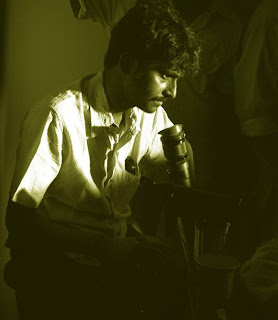Your Words on VTv :
For instance for the title shoot of VTV, we shot 200ft with crane up. When we saw the location I felt it would be good as a concept, he said ok though it was expensive. We had to hire an agela crane, take it to Kerala for just that one complicated shot to reveal the church. He gives a lot of freedom and inspires you a lot while narrating the scene or in the script.
He gave me the opportunity to use a lot of wide angle shots, scope and space for camera movements. This script he said it should be very visual and we made a color palette. Since I had already done this in Eeram, I was very happy to hear it from him and after doing so much dark, he wanted white, this gave me more energy. Usually, a love subject is colorful but he wanted white and first I could not understand. However, once I read the script, the character is Syrian Christian and many things about Jessie are white, the church white for instance. We searched a lot for white, the Thiruvanmiyur house gave us a white backdrop and so did the 450-year old Church where we got permission after a lot of persuasion and donation. Malta is an off white island city and this suited our color palette.
What was your best shot in VTV?
Going by the feedback, the Malta songs and New York were well-appreciated. In the Mannipaaya song, there is a lead scene, a night scene across the backwaters where Simbhu jumps over the wall to see Trisha and then they both sit on a lawn and talk. This is followed by an intense scene where they kiss and the song begins. He goes on the boat after this; we underplayed the moonlight and the place Allepey was new. Many appreciated this. I like this night effect scene.
How is Vinnaithaandi Varuvaayaa different from other films?
From the Tamil films I have come across, this has a very different screenplay and treatment. Usually, there are a lot of artistes, an action block and even in a love element; there might be vengeance and a lot of negative elements. Suppose they are not there, it would become a family drama. This script breaks all this. There are two characters and the only thing between them is love. The two characters keep talking to each other throughout the film, the supporting cast is very less, the cameraman character is the only major one and worked out well. Parents have a small role. This two character drama was new and interesting and it was wonderful working with artistes who had a lot of experience. I had a high energy level and confidence that I could give good visuals as it had such as structure.
How did you manage to give Simbhu an image makeover?
Many have asked this question. Trisha and Simbu look very good. We have done a lot of things that were not done in his earlier films. Basically, we decided his look. Hrithik Roshan’s hairstylist gave him the haircut. Nalini’s input was a lot and she gave him casual clothes generally middle class. She did not select them like a hero’s costume. Before shooting, his look was set and on my side, I planned and fixed the lighting pattern. The full film would be shot in sunlight and available light, back or direct. Even when scenes were shot at home, we decided to make it look like sunlight streamed in. White would look pure when the sunlight fell on it and shadows cast on it.
Unlike normal commercial films, we never gave Simbu special lighting but used a lot of available light, the reason for success of the makeover. In many places the duo were talking and the camera placed at a distance. In fact, many felt that it looked like two lovers who were captured on screen without their knowledge and this was appreciated. The reason is good planning without disturbing them with too much light and working in available light, maybe this looked fresh and new. Generally, for a hero, a lot of glow is used or he is given a backlight, both of which we avoided. Same goes for Trisha, her main scenes were done in available light. Only in the song sequences we have tried the glow because in his imagination we wanted her to look ravishing.
We selected good lighting conditions. I got enough co-operations from all three, Simbhu, Gautham and Trisha. When shooting in available light, when the sun’s direction changes, the continuity will change, usually, the sun will stay in a single angle only one or two hours but they completed the scene within that time frame. Generally other directors would take a lot of time and lot of shots, track movement and complicate it before finishing the scene. However, Gautham understood that would be good in available light and within one hour finished even big scenes. No rehearsals or retakes and many shots were okayed in a single take and this was good for the continuity and realism of the film.
Copyrights : Behindwoods.com
The article is of the author and all credits goes for him on taking this interview.
- Hariharan Gajendran

No comments:
Post a Comment